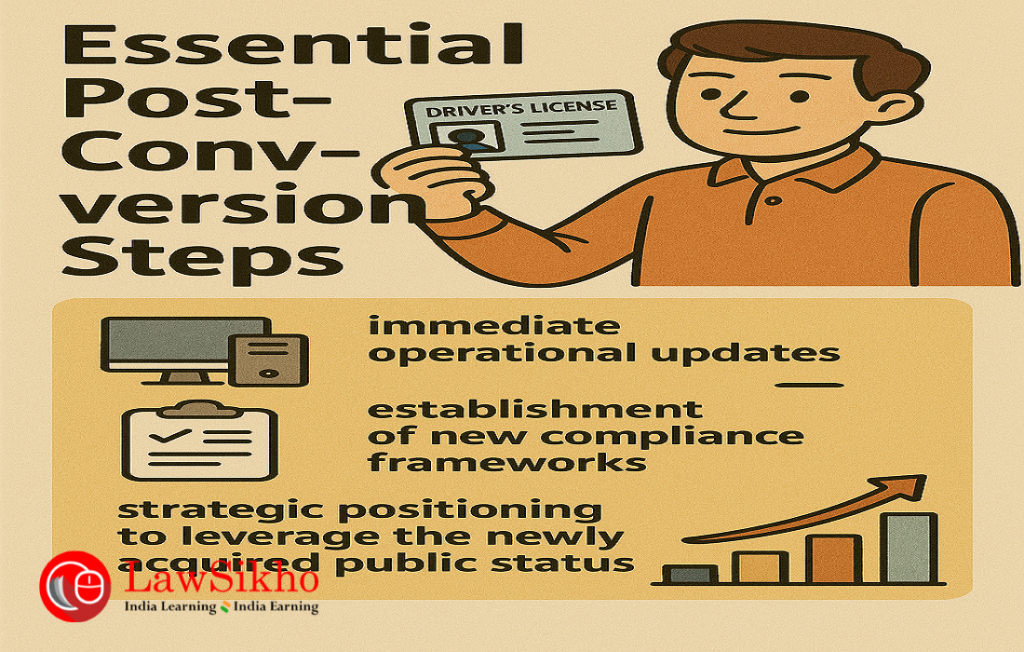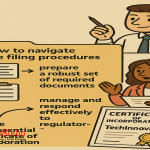Learn the practical steps to take after converting your company from private to public status, from updating documents to implementing new governance practices. Follow TechInnovate’s journey as they navigate life as a newly public company and maximise the benefits of their transformation.
Table of Contents
Introduction
During a late-night strategy session last month with the freshly minted executive team of TechInnovate Limited, CEO Rajiv Sharma turned to me with a look of bewildered accomplishment. “So that is it? We are public now?” he asked.
I could not help but smile. “That certificate hanging on your wall is just your admission ticket,” I told him. “The real performance is about to begin.“
Over the past three articles, I have walked you through TechInnovate’s journey from private to public status.
In the first article i.e., Navigating the legal essentials of company conversion: Private to Public, I assessed TechInnovate’s readiness for conversion, examining its shareholder structure, board composition, and strategic motivations for this significant transformation.
Building on that foundation, I, in the second article (From Private to Public Paperwork: Mastering the Essential MOA & AOA Modifications), guided you through the intricate process of amending TechInnovate’s foundational documents—the Memorandum of Association (MOA) and Articles of Association (AOA). Later, we secured the necessary internal approvals, first from the board of directors and then from shareholders at an Extraordinary General Meeting (EGM).
In the third article, I completed the regulatory process, filing the required forms with the Registrar of Companies (‘RoC’), navigating potential regulatory queries, and ultimately securing the all-important Certificate of Incorporation that officially recognised TechInnovate’s new public status.
Many corporate lawyers consider their job complete once the Certificate of Incorporation arrives.
This shortsighted approach leaves clients unprepared for the real work that follows.
As my first mentor at a law firm bluntly told me after my first conversion case, “Getting the certificate is like getting a driver’s license. It does not make you a good driver—only experience on the road can do that.“
For TechInnovate and any company making this transition, the post-conversion period is critical. It requires
- immediate operational updates,
- establishment of new compliance frameworks, and
- strategic positioning to leverage the newly acquired public status.
In this fourth article, I will guide you through these essential post-conversion steps, providing practical advice, templates, and checklists that will help you effectively counsel clients during this crucial transition period.
Whether you are a law student preparing for a corporate law career or a young lawyer handling your first post-conversion client, this article will equip you with the knowledge to manage this vital phase professionally and comprehensively.
By the end, you will understand not just what needs to be done immediately after conversion, but how to set your client up for long-term success as a public company, potentially even preparing them for the ultimate milestone of an Initial Public Offering (IPO).
Let us begin with the urgent actions that must be taken within the first 30 days after receiving the Certificate of Incorporation.
The 30-day sprint: urgent operational updates
The morning after TechInnovate received its new certificate, I gathered its top management team for what I call the “identity alignment” meeting.
“Your company has legally transformed,” I explained, “but until every document, account, and record reflects this change, you are operating in a dangerous gray area.”
While the Companies Act, 2013 does not specifically mandate a 30-day timeline for most post-conversion updates (except for specific filings like Form MGT-14 for resolutions), I recommended this timeframe as a best practice to minimise legal and operational risks. This 30-day window is critical because it establishes the company’s legal identity across all touchpoints.
Let me share precisely what I prioritised for TechInnovate during this period:
Update corporate identity
For TechInnovate, this meant that I had to assist them in a comprehensive sweep of all materials bearing their name:
- Company letterheads and invoice templates
- Email signatures for all 85 employees
- Website headers and legal pages
- LinkedIn, Twitter, and other social profiles
- Office signage at their Bangalore, Mumbai, and Pune locations
- Product documentation for their ManufactureSmart platform
What made this particularly challenging was consistency.
TechInnovate’s CTO Priya created what she called a “brand assets inventory”—a spreadsheet mapping every location where their name appeared, who owned that touchpoint, and verification when updated. This systematic approach prevented the common problem I have seen at other clients, where outdated branding lingers for months.
Notify stakeholders
Once the corporate identity materials were being updated, TechInnovate executed a carefully sequenced stakeholder notification plan:
- Employees: An all-hands meeting led by Rajiv, with follow-up department sessions
- Key clients: Personalised calls to their top 20 accounts, followed by formal letters
- Remaining clients: Formal notification letters with FAQs
- Vendors: Email notifications with updated billing information
- Banks: In-person meetings with updated documentation
- Regulatory bodies: Format filings with various authorities
For their employee communication, I helped craft a message that balanced excitement about the company’s growth with reassurance about cultural continuity. When announcing organisational changes, addressing anxiety is as important as explaining the change itself.
Click here to see the templates of the draft letters.
Financial and statutory record updates
The most technically complex part of the 30-day sprint involved updating financial and statutory records:
- Bank accounts (5 accounts across 3 different banks)
- GST registration
- PAN and TAN registration
- Provident Fund and ESI registrations
- Intellectual property registrations
Arjun Patel, TechInnovate’s CFO, developed what he called a “Change Management Tracker” that proved invaluable—a simple spreadsheet showing each registration, the process to update it, the responsible person, required documentation, submission date, and verification status.
A particular challenge arose with their HDFC bank account, where the bank initially requested board minutes explaining the conversion. We resolved this by providing both the special resolution and the Certificate of Incorporation, circumventing a potentially lengthy approval process.
Property and asset documentation
While not immediately obvious, TechInnovate also needed to update various property-related documents:
- Lease agreements for their three office locations
- Vehicle registrations for the company cars
- Fixed asset register and insurance policies
- Utility connections
These updates proved particularly time-consuming because they required coordination with external parties such as landlords, insurers, and government offices.
I recommend starting these processes immediately after conversion, as they typically take the longest to complete.
Here is a quick checklist for you to have a look at.
Building a public company compliance framework
With the immediate identity update underway, TechInnovate faced a different challenge: understanding and implementing public company compliance requirements.
When I sat down with Rajiv and his team to explain these changes, I noticed their apprehension. “Are we adding a whole compliance department?” Arjun asked nervously.
“Let us focus on what specifically changes for TechInnovate,” I suggested. “Not everything applicable to large public companies applies to you right now.”
This targeted approach works well for most clients. You should know that when a private company converts into a public company, it is not immediately required to comply with every obligation under the Companies Act.
Specific thresholds are prescribed under the Act, and only once these thresholds are crossed does compliance become mandatory.
In the following paragraphs, I will walk you through these thresholds and assess whether they apply to TechInnovate.
To make it easier for you, I am also extracting the part from the first article where I discussed TechInnovate’s financial standing.
Business Operations:
- headquartered in Bangalore with satellite offices in Mumbai and Pune
- 85 full-time employees (including 42 software developers)
- services over 120 clients across India, with recent expansion into Southeast Asian markets
- annual revenue of approximately ₹28 crores (FY 2024-25) with a healthy profit margin of 22%
Financial Structure:
- authorised capital: ₹2 crores
- paid-up capital: ₹1.2 crores
- turnover: ₹28 crores
- Net profit: ₹6.16 crores
- consistent year-over-year revenue growth of 30-35%
- bootstrapped initially, followed by two rounds of private investment
Current Ownership Structure:
- Founding Team (3 members): 51% equity
- Rajiv Sharma: 20%
- Priya Mehta: 16%
- Arjun Patel: 15%
- Angel Investors (2 individuals): 14% equity
- Vikram Malhotra: 8%
- Sunita Reddy: 6%
- Venture Capital Firm (GreenHorizon Ventures): 25% equity
- Employee Stock Option Pool: 10% equity
- Currently allocated to 12 senior employees
Total shareholders: 17 individuals
Instead of overwhelming TechInnovate with all possible requirements, I identified exactly which thresholds TechInnovate was triggered given their current size:
Board governance evolution
Independent directors’ requirement:
- Section 149(4) of the Companies Act requires one-third independent directors if:
- Paid-up capital exceeds ₹10 crores, OR
- Turnover exceeds ₹100 crores, OR
- Outstanding loans/debentures/deposits exceed ₹50 crores
With ₹1.2 crores paid-up capital and ₹28 crores turnover, TechInnovate has not yet triggered this requirement. However, their projected growth suggested they might cross the turnover threshold within 12-18 months.
Board committee requirements:
- Audit committee: Required for every listed companies and the classes of companies with paid-up capital of ₹10 crores or more, turnover of ₹100 crores or more, or outstanding loans/debentures/deposits exceeding ₹50 crores, as per section 177 read with Rule 6 of the Companies (Meetings of Board and its Powers) Rules, 2014
- Nomination & remuneration committee: Same thresholds as Audit Committee
- Stakeholders’ relationship committee: Required for public companies with 1,000+ shareholders, debenture holders, deposit holders, and any other security holders in aggregate, as per section 178(5) of the Companies Act, 2013
TechInnovate’s situation: With only 17 shareholders, they were not required to establish these committees immediately. However, we began identifying potential independent directors for future appointments.
Check out the templates of the draft charter of the Audit Committee, Nomination & Remuneration Committee, and Stakeholders’ Relationship Committee.
Financial disclosure enhancements
While both private and public companies file similar forms, public companies face stricter requirements:
- Cash flow statement: Not mandatory for TechInnovate at its current size since it does not meet the thresholds under Rule 4 of The Companies (Indian Accounting Standards) Rules, 2015 (net worth ≥ ₹250 crores or borrowings ≥ ₹50 crores). However, preparing one voluntarily is good practice for management decision-making and investor transparency.
- Segment reporting: Similarly, not required unless TechInnovate becomes subject to Indian Accounting Standards (Ind AS) 108 by crossing the applicable thresholds.
- Consolidated financial statements: Would be required under section 129(3) only if they acquired subsidiaries and became a holding company.
Arjun noted their auditors had already prepared most of these reports voluntarily as a best practice, even though they were not all statutory requirements at TechInnovate’s current size. This proactive approach would serve them well as they grow toward these regulatory thresholds.
Strategic appointments and policies
Company Secretary:
- Required for public companies with paid-up share capital of ₹10 crores or more, as per Rule 8A of the Companies (Appointment and Remuneration of Managerial Personnel) Rules, 2014
TechInnovate had already engaged a part-time Company Secretary while private, so this did not trigger an immediate requirement for them.
Internal Auditor:
Required for unlisted public companies with any one of the following during the preceding financial year:
- Paid-up capital of ₹50 crores or more, OR
- Turnover of ₹200 crores or more, OR
- Outstanding loans/borrowings from banks/public financial institutions exceeding ₹100 crores at any point during the preceding financial year, OR
- Outstanding deposits of ₹25 crores or more at any point during the preceding financial year
This requirement is based on section 138 read with Rule 13 of the Companies (Accounts) Rules, 2014. With TechInnovate’s current financials (₹1.2 crores paid-up capital, ₹28 crores turnover), this requirement is not triggered.
Again, TechInnovate’s current size did not trigger this requirement.
Here is a template for the Compliance Threshold Tracker.
Corporate policies
Certain policies become mandatory for a public company only when specific thresholds are crossed by such a public company:
- Corporate social responsibility (CSR) policy: Required for any company (private or public) with a net worth of ₹500 crores or more, a turnover of ₹1,000 crores or more, or a net profit of ₹5 crores or more during the immediately preceding financial year (Section 135).
Any one of these criteria is sufficient to trigger the requirement. TechInnovate’s situation: With a net profit of ₹6.16 crores, TechInnovate exceeds the ₹5 crore threshold, making CSR compliance mandatory.
We advised the company to:
- Constitute a CSR Committee with at least three directors (including one independent director once appointed)
- Formulate a CSR Policy outlining activities to be undertaken
- Allocate 2% of its average net profits of the past three financial years toward CSR activities
- Include a CSR report in its annual board report.
- Vigil mechanism (Whistleblower Policy): Mandatory for listed companies and public companies that:
- Accept deposits from the public, OR
- Have borrowed money from banks and public financial institutions exceeding ₹50 crores at any point during the financial year (section 177(9) read with Rule 7 of the Companies (Meetings of Board and its Powers) Rules, 2014).
Given that TechInnovate does not currently accept public deposits or have borrowings exceeding ₹50 crores, this requirement is not triggered. However, we advised keeping this requirement in mind as the company grows.
Click here to see the draft template of both corporate policies.
Given the financial standing of TechInnovate, there was no immediate need to implement these two corporate polices required based on its current financials.
Important note
While TechInnovate may not currently trigger many of these thresholds, as a legal advisor, you must always conduct a thorough assessment of your client’s specific situation. Remember that:
- The thresholds mentioned are based on current provisions of the Companies Act, which may be amended from time to time
- Companies can cross these thresholds rapidly, especially high-growth ventures like TechInnovate
- Some clients may prefer to implement higher governance standards voluntarily, even before they are legally required
I recommend that you create a “Compliance Threshold Tracker” for each client that identifies:
- current distance from each threshold
- projected date when each threshold might be crossed based on growth forecasts
- lead time needed to implement each requirement
- responsible person for monitoring and implementation
This proactive approach prevents compliance surprises and allows companies to build governance capabilities gradually rather than scrambling to implement everything at once when thresholds are crossed.
Leveraging public status for strategic advantage
After helping TechInnovate navigate the initial hurdles of becoming a public company, I sat down with Rajiv and his management team for what I call a “strategic opportunities session.”
“You have done all this work to become public,” I said. “Now let us talk about how to actually benefit from it.“
Rajiv looked surprised. “I thought becoming public was mostly about compliance requirements.“
This is a common misconception.
Many companies treat conversion as just a legal requirement or a stepping stone to an IPO, missing the immediate advantages it can bring. I explained to TechInnovate’s team that their new status could open doors right away if they used it strategically.
Let me show you how.
Raising money just got easier
“Remember that funding round you were struggling with last quarter?” I asked Arjun. “Your public status can help with that.“
I explained to TechInnovate’s management that certain investors simply would not look at private companies. It’s not that they do not like them – it’s just their investment policy.
“There are at least five institutional investors I know who focus specifically on companies that are public but not yet listed,” I told them. “They see these companies as less risky than pure startups but with more growth potential than listed companies.“
I helped TechInnovate create a targeted investor presentation that highlighted their public company governance. Within six months, they secured ₹15 crores from two institutional investors who typically would not have considered them while they were private.
“One investor literally told me they would not have taken the meeting if we were still private,” Arjun later shared.
Attracting star employees
During a review of TechInnovate’s hiring challenges, I noticed they were struggling to attract senior technical talent from larger companies.
“Your public status can be a hiring advantage,” I explained. “When recruiting experienced people from established companies, you offer something most startups can’t – the perception of stability combined with growth potential.“
I advised TechInnovate to revamp their recruitment materials to emphasise:
- their public company governance standards
- the potential future liquidity of their equity compensation
- their unique position as an innovative but well-governed organisation
We worked together to create a “Why Join Us” presentation that Priya now uses in interviews. Over the next eight months, TechInnovate successfully recruited three senior technical leaders from larger competitors – each mentioned the company’s public status during their interviews.
“One of our new hires said he would not leave his stable job for a typical startup, but our public status gave him confidence,” Priya told me.
Getting through big companies’ doors
“Remember that automotive manufacturer that would not even return your calls last year?” I asked Rajiv during our strategy session. “Let’s try them again.”
Many large enterprises have procurement processes that favor public companies. They see them as more stable, transparent, and accountable. I helped TechInnovate revise their enterprise sales approach to highlight their public status during initial conversations with large prospects.
“Do not make it the focus of your pitch,” I advised their sales team. “But mention it early to get past the initial risk assessment that often screens out smaller companies.“
This approach worked remarkably well.
That same automotive manufacturer who had previously declined to work with TechInnovate reopened discussions and eventually became a client.
During the contract negotiation, their procurement officer specifically mentioned TechInnovate’s public status as a factor that helped them clear their vendor approval process.
Growing through acquisitions
When TechInnovate identified a complementary software company they wanted to acquire, I helped them leverage their public status during negotiations.
“Offering shares in a public company is very different from offering shares in a private company,” I explained to Rajiv. “The founders you are acquiring will see a clearer path to liquidity.“
We structured an acquisition offer that included shares as part of the consideration. This reduced the cash outlay TechInnovate needed upfront, making the deal financially feasible.
The target company’s founders accepted shares as partial payment specifically because of TechInnovate’s public status.
Building investor confidence
To help TechInnovate maintain strong relationships with their existing investors while attracting new ones, I suggested implementing more formal investor relations practices.
“You do not need an entire investor relations department,” I explained, “but some basic structures will build tremendous trust.“
I helped them create:
- A quarterly business review template that provided consistent information
- A simple protocol for sharing material developments with all shareholders
- A more transparent approach to governance reporting
These practices were especially appreciated by GreenHorizon Ventures, which had been considering an exit from their investment. After seeing the improved transparency and governance, they instead extended their investment timeline.
“Your transition to public company practices gave us confidence that you are building for the long term,” their partner told Rajiv.
The key lesson here?
Do not just become public on paper. Use your new status strategically to open doors that were previously closed to you. That is where the real value of conversion lies.
Navigating post-conversion challenges
After TechInnovate became a public company, it faced several common challenges.
As a young lawyer, understanding these challenges will help you guide clients through this critical transition period.
“Why do we suddenly need to explain everything?”
“I have never had to answer so many questions about our finances before,” CFO Arjun told me during our first post-conversion meeting. Despite having only 17 shareholders, TechInnovate suddenly found itself fielding detailed inquiries from all directions.
Their bank now requested quarterly reviews, while GreenHorizon Ventures began asking for monthly metrics they were not even tracking internally. When auditors arrived, their checklist was three times longer than the previous year’s.
To help TechInnovate manage this scrutiny, I created quarterly update templates, prepared customisable information packets for different stakeholders, and recommended improvements to their financial record-keeping system.
“But we used to make decisions in minutes!”
“Ca not we just decide this now?” Rajiv asked when I explained that their new product pricing model needed board approval first.
This frustration highlighted TechInnovate’s second challenge. The founding team built the company on quick decisions, but now faced more structured governance. Board meetings stretched from one hour to half a day as directors asked detailed operational questions.
I helped them balance governance with efficiency by developing a “Decision Authority Chart,” establishing monthly mini-meetings between quarterly board meetings, and conducting training sessions explaining the importance of new policies.
Six months later, Rajiv admitted, “Our governance formalisation actually improved our decision quality with only modest impact on speed.“
“Same team size, double the paperwork.”
The third month after conversion, TechInnovate’s compliance coordinator Ananya, showed me a calendar covered in highlighted dates. “There is no way we can keep up with all these deadlines with our current team,” she said.
Rather than hiring three new specialists as she proposed, I suggested a more measured approach:
- selecting a coordinator from their existing team,
- introducing a simple compliance management tool,
- connecting them with trusted external experts, and
- creating a training roadmap to build internal capabilities.
This approach saved approximately ₹30 lakhs in first-year personnel costs while ensuring compliance with all requirements.
“Are we still a startup at heart?”
“Some of our best engineers are worried we are becoming too ‘corporate,‘” Priya, the CTO, told me two months after conversion.
During a town hall, one developer asked bluntly: “Are we still going to take risks and move fast?“
I worked with leadership to balance governance with cultural preservation by facilitating a values workshop, advocating for their quarterly “innovation days” program, and forming a “culture preservation team” with long-time employees.
“So when are you going public…I mean really public?”
For TechInnovate, countless variations of “When are you listing?” created tangible business challenges.
Strategy discussions frequently derailed into debates about potential listing impact, while some sales team members began promising prospects that TechInnovate would soon be a listed company.
I helped them manage these expectations by drafting a communication strategy focused on business milestones rather than dates, developing an “Authorised Spokespersons Policy,” and organising educational sessions about capital markets for employees.
Most post-conversion challenges can be solved with practical approaches rather than complex solutions. By anticipating these issues, you wi’ll provide valuable guidance beyond just the legal mechanics of conversion.
Conclusion
Throughout this four-article series, we followed TechInnovate’s comprehensive journey from private to public status.
From initial assessment and document modifications to regulatory filings and post-conversion strategies, each step has illustrated the multifaceted nature of this transformation.
Like I said multiple times, the conversion process is not merely a legal formality but a strategic business evolution that creates both challenges and opportunities.
By maintaining operational agility while embracing enhanced governance standards, TechInnovate successfully leveraged its public status to attract capital, talent, and new business opportunities.
Always remember that conversion is just the beginning—the real value emerges in how effectively a company adapts to and capitalises on its new status.
For young lawyers and law students, mastering this complex process offers an opportunity to position yourselves not just as technical practitioners but as strategic advisors guiding clients through one of the most significant transitions in their corporate lifecycle.






 Allow notifications
Allow notifications
